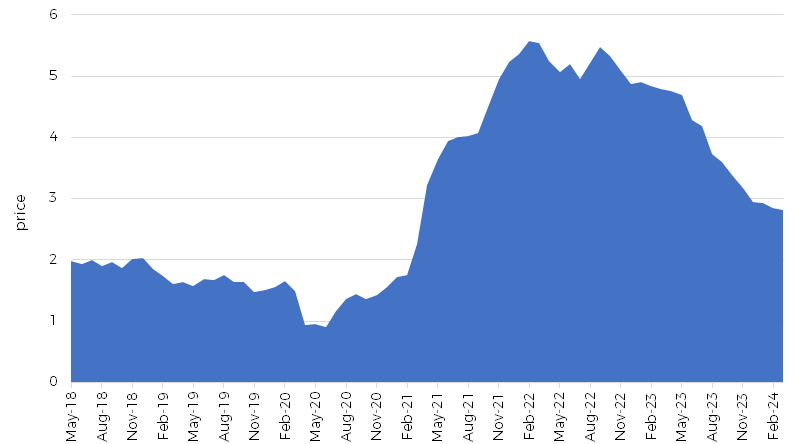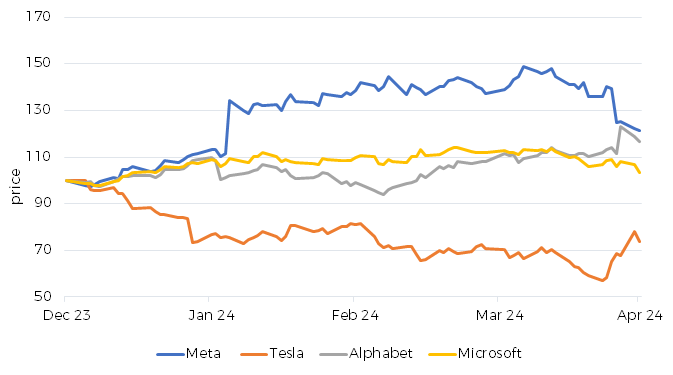In this latest Market Watch from Premier Miton’s Chief Investment Officer Neil Birrell, he reflects on weaker than expected economic growth and higher than expected inflation in the US, as well as the divergence of the Magnificent 7 – and he offers a quick peek into May and June. Will May bring flowers after April showers?
For information purposes only. Any views and opinions expressed here are those of the author at the time of writing and can change; they may not represent the views of Premier Miton and should not be taken as statements of fact, nor should they be relied upon for making investment decisions.
Investing involves risk. The value of an investment can go down as well as up which means that you could get back less than you originally invested when you come to sell your investment. The value of your investment might not keep up with any rise in the cost of living.
Premier Miton is unable to provide investment, tax or financial planning advice. We recommend that you discuss any investment decisions with a financial adviser.
April – in brief
- How the US economy is performing is a key issue and maybe it’s not doing as well as we all thought.
- Financial markets look to the future but also react to the past, making April a poor month for returns.
- Mixed news and mixed share price reactions from the Magnificent 7.
It’s all going very well… or is it?
The US Department of Commerce released its initial estimate of economic growth, which showed the economy expanding at an annualised rate of 1.6%, below economists’ forecasts of 2.5% and the slowest pace for nearly two years.
A sharp slowdown in government spending as well as a steep rise in imports (driven by strong consumer spending) were the main reasons for slowdown. However, there are many measures of the strength of an economy and others remain robust. Perhaps, more importantly, we should not put too much emphasis on one data point and concentrate on the underlying trends.
We also had the release of the US Federal Reserve central bank’s (Fed) preferred measure of inflation, the personal consumption expenditure (PCE) index, which rose by 2.8% in March, still far from the Fed’s 2% target and slightly worse than the 2.7% expected. Following the earlier release of other ‘hotter’ inflation measures, however, financial markets were braced for a far worse number so in the end the small difference was received with relief.
In essence, weaker than expected economic growth and higher than expected inflation is not good news. It means that the Fed will be under pressure not to cut interest rates, in order to tame inflation, which is likely to have the effect of slowing the economy further. As noted above, the trend is the important factor, so we will be keeping a close eye on the data as it comes out as always. As the chart below shows, year on year the PCE index was falling nicely from the peak, but it has not made much more progress this year.
US Personal Consumption Expenditure Index year on year change ($)

Source: Bloomberg 31.05.2018 – 31.03.2024.
April showers for financial markets
The April weather lived up to its reputation and financial markets were a bit soggy as well.
After a strong first three months of the year, equity markets reacted to the weaker US economic growth and moved lower.
Weaker economic growth can lead to lower corporate profitability, which is normally seen as negative for equity markets. When combined with higher than hoped for inflation, meaning less likelihood of interest rates falling, an unappetising cocktail for share prices is the result.
Furthermore, given the previous strength, it was unsurprising to see a reaction. However, the year to the end of April was still a profitable one for most regions. Japan led the way, with Europe following and the US close behind that.
Bond markets reacted in the same way, albeit not coming off a positive first quarter, when the hopes for interest rate cuts went into reverse. This was the case for bonds issued by both governments and companies.
The Magnificent 7 – the band is breaking up
Earlier in the year I wrote about how the share prices of the Magnificent 7 giant US technology and communications companies sending stock markets higher might stop behaving as a group, and that would be driven by how each individual company is performing in terms of revenues and profitability.
We are in the midst of the reporting season for corporate profits for the first quarter of the year. So far, we have seen a big variance in how the members of the Magnificent 7 are getting on.
Tesla’s share price has been doing badly over the last few months and it delivered results that were very poor, but the share price rose sharply as Elon Musk announced his company’s ambition to deliver low-cost electric vehicles by the end of the year.
Meta Platforms (Facebook) delivered good numbers, but the shares declined in the short term, as investors reacted poorly to its margin-sapping ambition to accelerate spending on artificial intelligence.
Meanwhile Alphabet (Google) was the only one to experience a significant share price gain on decent results, although likely more in relief given the poor performance in the previous quarter. Although Microsoft’s shares also rose modestly following its results.
We await news from Apple, Nvidia and Amazon, although it does look like the share prices of the members of the band are beginning to reflect their own talents rather than just being in the band, and it’s not all good news, by any means.
The next chart (overleaf) shows the share prices of Meta, Tesla, Alphabet and Microsoft this year up to the end of April. The share prices have been rebased to 100 to show how they have differed.
Meta, Tesla, Alphabet and Microsoft share prices to end of April ($)

Source: Bloomberg 29.12.23 – 30.2.24. Chart rebased to 100 on 29.12.23.
The performance information presented on this page relates to the past. Past performance is not a reliable indicator of future returns.
A quick peek into May and June – all eyes on interest rates
The Fed met on 1 May and, as expected, left US interest rates unchanged. All eyes and ears were on the comments from Jerome Powell, the chair, as he stated that it was too early to cut interest rates given the level of inflation but said it might be appropriate to do so at some point this year. Again, much as expected. There had been fears of the next move being an upward one, but those were allayed by Powell.
The European Central Bank do not meet in May, but there is an expectation that they will announce an interest rate cut at their meeting in early June. Meanwhile there is a lack of clarity as to what the Bank of England may do, with a cut being announced in August or September the current assumption.
For now, the main games in town remain monitoring inflation and worrying about economic growth as they are two factors that will drive interest rate policy.
Glossary
Bonds
Types of investments that allow investors to loan money to governments and companies, usually in return for a regular fixed level of interest until the bond’s maturity date, plus the return of the original value of the bond at the maturity date. The price of bonds will vary, and the investment terms of bonds will also vary.
Inflation
The increase in the general price level of goods and services in an economy.
Share price
The amount it would cost to buy one share in a company; it is not fixed but fluctuates for many reasons, including the success of the company and market conditions.

